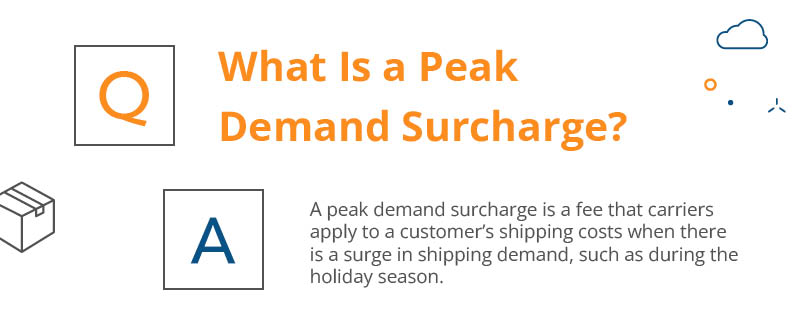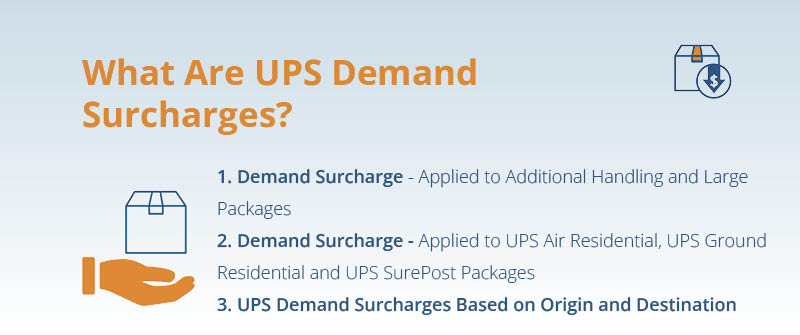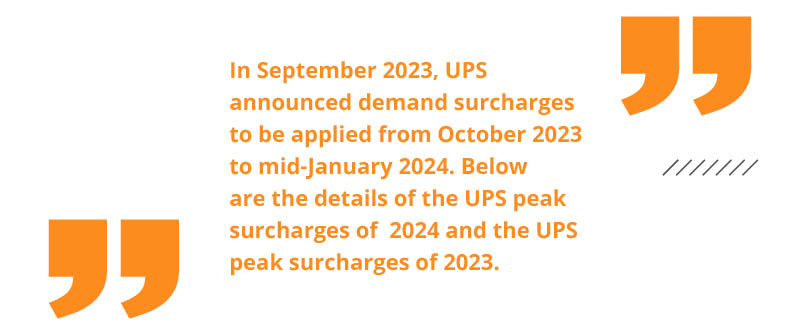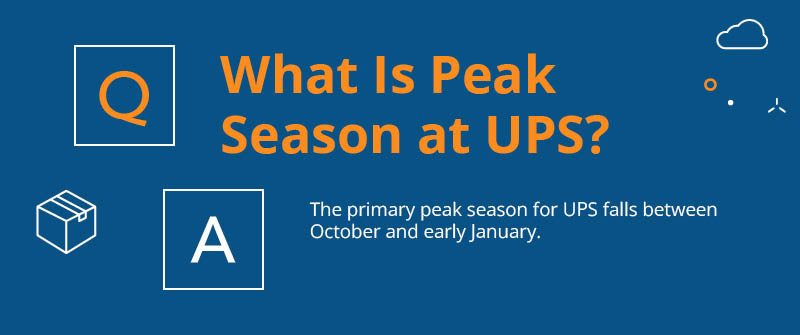UPS Demand Surcharges
October 12, 2023 •Joe Jordan

It's that time of year when online shopping and shipping reach their peak as people prepare for the holiday season. However, for businesses that rely heavily on shipping during this period, the festive season brings an unwelcome guest: demand surcharges.
In this blog, we will examine UPS demand surcharges to help you gain a better understanding of them and manage them effectively to prevent overpaying for your shipping costs.
What Is a Peak Demand Surcharge?
A peak demand surcharge is a fee that carriers apply to a customer's shipping costs when there is a surge in shipping demand, such as during the holiday season. Shipping companies impose this surcharge to cover the additional operational expenses incurred when handling a significantly higher volume of packages and serving more customers.
The main peak season surcharge is typically imposed by carriers from October to early January, spanning holidays like Thanksgiving, Christmas, and New Year's Day.

What Is a Peak Demand Surcharge for UPS?
A peak demand surcharge for UPS is an extra fee that UPS charges (either per lb or per package) during periods of the year when shipping demand is significantly higher than usual.
As a UPS customer, your shipment might be subject to one or more demand surcharges during specific "demand periods." The specific surcharges and their amounts are determined by factors like the shipment's origin, destination, and the chosen service levels.
Keep in mind that UPS peak surcharges are subject to fluctuations, and the duration or conditions of demand periods may be extended or modified.
What Are UPS Demand Surcharges?

Below is a list of current UPS demand surcharges as of September 2023:
- Demand Surcharge – Applied to Additional Handling and Large Packages
- UPS applies this surcharge to packages that are larger than average and to shipments that require additional handling due to their size or special packaging requirements.
- Demand Surcharge – Applied to UPS Air Residential, UPS Ground Residential and UPS SurePost Packages
- This UPS demand surcharge is applied to certain UPS Air Residential, UPS Ground Residential, and UPS SurePost packages for customers who exceed a predetermined shipping volume.
- UPS Demand Surcharges Based on Origin and Destination.
- This ups peak surcharge is applied based on different origin and destination pairs, as shown below. Check out the UPS surcharge document for rates of the following.
- Demand Surcharge – Applied to shipments from China Mainland, Hong Kong SAR, or Macau SAR to the U.S.2
- Demand Surcharge – Applied to shipments from Australia, New Zealand, or other Asia origins to the U.S.
- Demand Surcharge – Applied to shipments from the U.S. to Australia or New Zealand
- Demand Surcharge – Applied to shipments from European origins to the U.S. or North America
- Demand Surcharge – Applied to shipments from India to the U.S. or North America
- Demand Surcharge – Applied to UPS Standard shipments from Canada to the U.S. and UPS Trade Direct shipments from the U.S. to Canada
- Demand Surcharge – Applied to international shipments from Mexico to all destinations (except Australia and New Zealand)
- Demand Surcharge – Applied to international shipments from the U.S. to Canada
- Demand Surcharge – Applied to international shipments from the U.S. to Europe
- Demand Surcharge – Applied to international shipments from the U.S. to all destinations (except Australia,
- Canada, Europe, and New Zealand)
- Demand Surcharge – Applied to international shipments from all origins to all destinations (except shipments covered in the list above)
- This ups peak surcharge is applied based on different origin and destination pairs, as shown below. Check out the UPS surcharge document for rates of the following.
Is UPS Charging a Surcharge During Peak Demand?
UPS is putting in place a surcharge during the 2023 peak demand period, just like they've done in previous years. They keep these demand surcharges going from January to September, but the rates are a bit lower during that time. Come September, they raise the rates for the peak season, as illustrated in the tables in the following sections.
Why Is UPS Charging a Surcharge During Peak Demand?
UPS, like other carriers, imposes extra fees during demand periods for various reasons, including:
- Increased operational costs: During peak season, UPS incurs higher operational expenses due to the need for additional resources and increased labor to handle the surge in shipments.
- Maintaining service quality: Imposing surcharges helps UPS manage the higher volume effectively without compromising on delivery standards.
- Encouraging efficient shipping: To avoid surcharges, customers are incentivized to plan their shipping more efficiently and avoid last-minute rushes.
- Balancing supply and demand: By applying surcharges, UPS can balance supply and demand, preventing the network from becoming overwhelmed and improving the overall shipping experience for customers.
- To balance rates throughout the year: UPS applies surcharges during peak periods to cover the higher costs linked to high-demand seasons and make up for the lower rates charged during off-peak times.
How Can I Avoid UPS Surcharges During Peak Demand?
Demand surcharges can significantly impact your shipping costs. Use the tips below to minimize or eliminate these charges during peak demand periods:
- Ship early or late: Try to schedule shipments outside of peak demand periods. Ship earlier or later in the year to avoid the highest surcharge rates.
- Optimize packaging: Pack your items efficiently to avoid shipping correction charges like ‘large package’ and ‘additional handling’ surcharges.
- Negotiate with UPS: If you have a significant shipping volume, consider negotiating shipping contracts with UPS. This can sometimes provide you with more favorable terms and exemptions from certain surcharges.
- Use other carriers: Look through other carrier’s peak rates, compare with UPS, and pick the most cost-effective option.
- Monitor your shipping volume: Keep an eye on your shipping volume and adjust your shipping strategy accordingly. If you're approaching volume thresholds that trigger surcharges, consider consolidating shipments or spacing them out.
- Plan ahead for peak seasons: Anticipate peak seasons and plan your shipping schedule accordingly. For instance, consider ordering inventory well in advance to avoid surcharges on bulk shipments.
- Stay informed on UPS policies: Keep checking the UPS surcharges page to stay up-to-date with UPS’ surcharges and their respective amounts and conditions. This information will help you plan your shipping budget more effectively.
- Opt for off-peak services: Consider using UPS services that are not subject to peak surcharges if they meet your delivery needs.
- Work with a parcel shipping expert: They can assist you in understanding UPS's surcharge policies and conducting audits on your invoices to enhance your shipping strategy.
What Will UPS Surcharges Be In 2024?
In September 2023, UPS announced demand surcharges to be applied from October 2023 to mid-January 2024. Below are the details of the UPS peak surcharges of 2024 and the UPS peak surcharges of 2023.

A. Demand Surcharge – Applied to Additional Handling and Large Packages
|
Surcharge |
Current Surcharge amount (Jan. 15, 2023–Sep. 30, 2023) |
New Surcharge amount (Oct. 1, 2023–Jan. 13, 2024) |
|
Additional Handling |
$3.50 per package |
$6.90 per package |
|
Large Package Surcharge |
$40.00 per package |
$74.90 per package |
|
Over Maximum Limits |
$0.00 per package |
$410.00 per package |
B. Demand Surcharge – Applied to UPS Air Residential, UPS Ground Residential, and UPS SurePost Packages
This Demand Surcharge will apply to certain UPS Air Residential, UPS Ground Residential, and UPS SurePost packages. The Demand Surcharge amounts below will apply on a weekly basis to each package over 105% of the Baseline weekly average volume for each service level during the specified Demand Period.
Current Rates
Applicable from January 15, 2023 until October 28, 2023
Applies to: Customers who are charged for over 20,000 packages during any week following October 2021
|
Service Level |
>105% to 125% of Baseline Volume |
>125% to 150% of Baseline Volume |
>150% of Baseline Volume |
|
UPS SurePost |
$0.40 per package |
$0.50 per package |
$0.60 per package |
|
UPS Ground Residential |
$0.40 per package |
$0.50 per package |
$0.60 per package |
|
UPS Next Day Air Residential |
$0.40 per package |
$0.50 per package |
$0.60 per package |
|
All Other UPS Air Residential |
$0.40 per package |
$0.50 per package |
$0.60 per package |
Upcoming Rates
Applicable from October 29, 2023 until January 13, 2024
Applies to: Customers who are charged for over 20,000 packages during any week following October 2022
|
Service Level |
>105% to 125% of Baseline Volume |
>125% to 150% of Baseline Volume |
>150% to 200% of Baseline Volume |
>200% to 300% of Baseline Volume |
>300% to 400% of Baseline Volume |
>400% of Baseline Volume |
|
UPS SurePost |
$1.35 per package |
$1.85 per package |
$2.15 per package |
$2.60 per package |
$4.45 per package |
$6.40 per package |
|
UPS Ground Residential |
$1.35 per package |
$1.85 per package |
$2.15 per package |
$2.60 per package |
$4.45 per package |
$6.40 per package |
|
UPS Next Day Air Residential |
$2.40 per package |
$2.90 per package |
$3.20 per package |
$3.65 per package |
$5.50 per package |
$7.50 per package |
|
All Other UPS Air Residential |
$2.40 per package |
$2.90 per package |
$3.20 per package |
$3.65 per package |
$5.50 per package |
$7.50 per package |
Once the peak season is over, UPS will announce new surcharge amounts to be applied between January and September of 2024.
Visit the UPS Demand Surcharges page for more information on UPS demand surcharges 2024.
What Is Peak Season at UPS?
The primary peak season for UPS falls between October and early January. During this time, there is a significant uptick in online shopping, gift sending, supply orders, and various other activities compared to the rest of the year. Consequently, there is a substantial increase in the demand for shipping services.

How ShipSigma Can Help
At ShipSigma, we harness over $1 billion of live market data and over 250 years of combined shipping experience to identify specific cost-saving opportunities.
Contact us today to join 300+ customers enjoying an average of 25% savings on their shipping fees.

